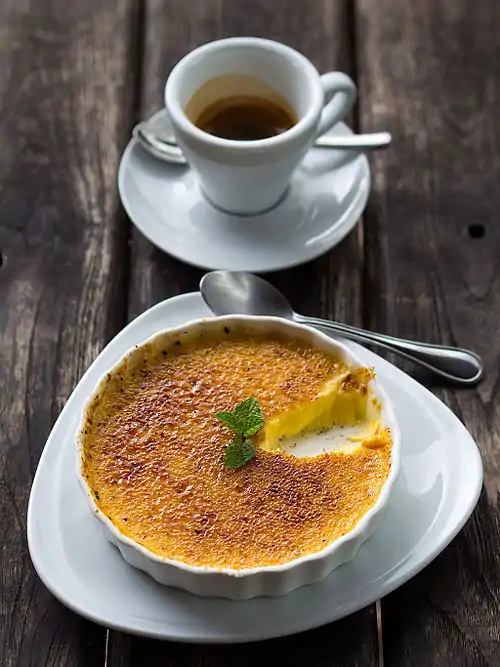Crème brûlée
Crème brûlée (/ˌkrɛm bruːˈleɪ/; French pronunciation: [kʁɛm bʁy.le]), also known as burned cream, burnt cream or Trinity cream,[1] and similar to crema catalana, is a dessert consisting of a rich custard base topped with a layer of hardened caramelized sugar. It is normally served slightly chilled; the heat from the caramelizing process tends to warm the top of the custard, while leaving the center cool. The custard base is traditionally flavored with vanilla in French cuisine, but can have other flavorings. It is sometimes garnished with fruit.
 | |
| Alternative names | Burned cream, Burnt cream, Trinity cream, Cambridge burnt cream |
|---|---|
| Course | Dessert |
| Place of origin | France |
| Serving temperature | Room temperature |
| Main ingredients | Cream, sugar, egg or egg yolks, vanilla |
History
The earliest known recipe for crème brûlée appears in François Massialot's 1691 cookbook Cuisinier royal et bourgeois.[2][3] The name "burnt cream" was used in the 1702 English translation.[4] In 1740, Massialot referred to a similar recipe as crême à l'Angloise; 'English cream'.
The dish then vanished from French cookbooks until the 1980s.[2] A version of crème brûlée (known locally as "Trinity Cream" or "Cambridge burnt cream") was introduced at Trinity College, Cambridge, in 1879 with the college arms "impressed on top of the cream with a branding iron".[1]
Crème brûlée was uncommon in French and English cookbooks of the nineteenth and twentieth centuries.[5] It became extremely popular in the 1980s, "a symbol of that decade's self-indulgence and the darling of the restaurant boom",[6][7] probably popularized by Sirio Maccioni at his New York restaurant Le Cirque. He claimed to have made it "the most famous and by far the most popular dessert in restaurants from Paris to Peoria".[5][8]
Technique
Crème brûlée is usually served in individual ramekins. Discs of caramel may be prepared separately and put on top just before serving, or the caramel may be formed directly on top of the custard immediately before serving. To do this, sugar is sprinkled onto the custard, then caramelized under a red-hot salamander (a cast iron disk with a long wooden handle) or with a butane torch.[9]
There are two methods for making the custard. The more common creates a "hot" custard by whisking egg yolks in a double boiler with sugar and incorporating the cream, adding vanilla once the custard is removed from the heat.[10] Alternatively, the egg yolk/sugar mixture can be tempered with hot cream, then adding vanilla at the end. In the "cold" method, the egg yolks and sugar are whisked together until the mixture reaches ribbon stage. Then, cold heavy cream is whisked into the yolk mixture followed by vanilla. It is then poured into ramekins and baked in a bain-marie.[11]
See also
- Crème caramel, also known as flan (not to be confused with the English flan)
- Crema catalana
- List of custard desserts
- List of French desserts
References
- Alan Davidson (21 August 2014). The Oxford Companion to Food. OUP Oxford. p. 230. ISBN 978-0-19-104072-6.
- The Oxford Companion to Sugar and Sweets. Oxford University Press. 1 April 2015. pp. 383–. ISBN 978-0-19-931362-4.
- Jane Grigson (1 January 1985). Jane Grigson's British Cookery. Atheneum.
- Harold McGee (20 March 2007). On Food and Cooking: The Science and Lore of the Kitchen. Simon and Schuster. p. 97. ISBN 978-1-4165-5637-4.
- Darra Goldstein, ed., The Oxford Companion to Sugar and Sweets, 2015, ISBN 0199313393, s.v. 'Crème brûlée'
- Colman Andrews (3 December 2005). Catalan Cuisine, Revised Edition: Vivid Flavors From Spain's Mediterranean Coast. Harvard Common Press. pp. 247–. ISBN 978-1-55832-329-2.
- Richard Sax (9 November 2010). Classic Home Desserts: A Treasury of Heirloom and Contemporary Recipes. Houghton Mifflin Harcourt. pp. 149–. ISBN 0-547-50480-2.
- Sirio Maccioni, Peter Elliot, Sirio: The Story of my Life and Le Cirque, 2004, ISBN 0471204560, p. 216
- Cloake, Felicity (19 September 2012). "How to cook perfect creme brulee". The Guardian. Retrieved 9 September 2016.
- "Vanilla-bean creme brulee". www.taste.com.au. 25 November 2010. Retrieved 20 August 2018.
- https://gourmet.lovetoknow.com/Creme_Brulee_History
Bibliography
- "Origin of Crème Brûlée", Petits Propos Culinaires 31:61 (March 1989).
External links
| Wikimedia Commons has media related to Crème brûlée. |
| Wikibooks has a book on the topic of: Cookbook:Crème Brûlée |
 The dictionary definition of crème brûlée at Wiktionary
The dictionary definition of crème brûlée at Wiktionary